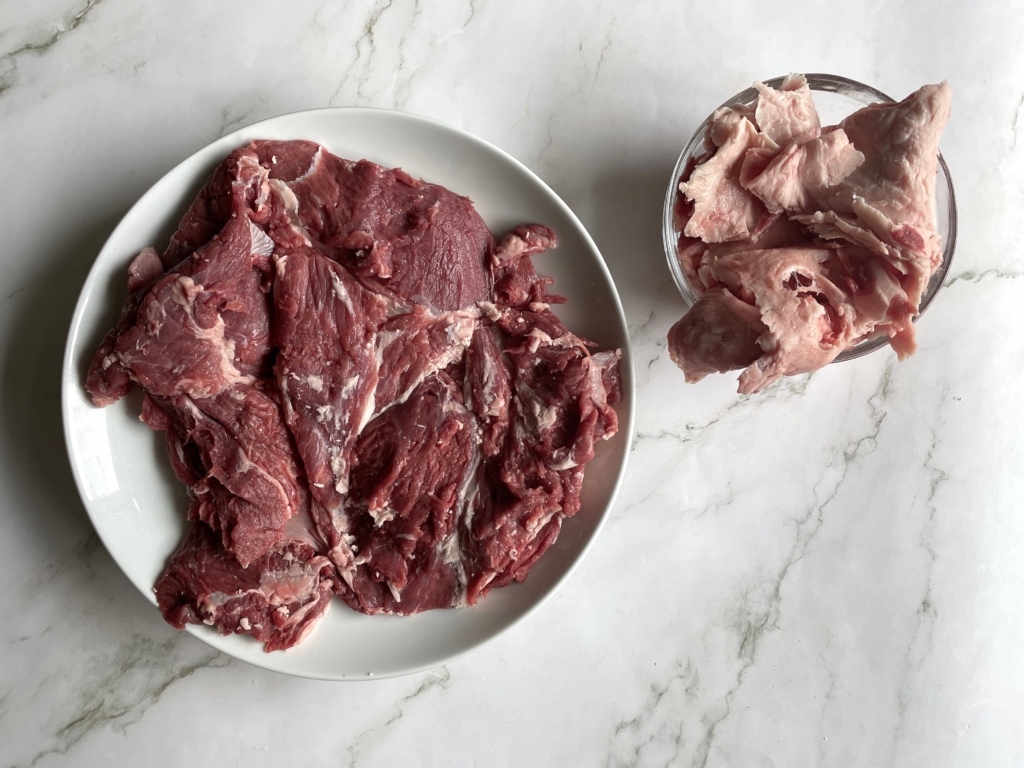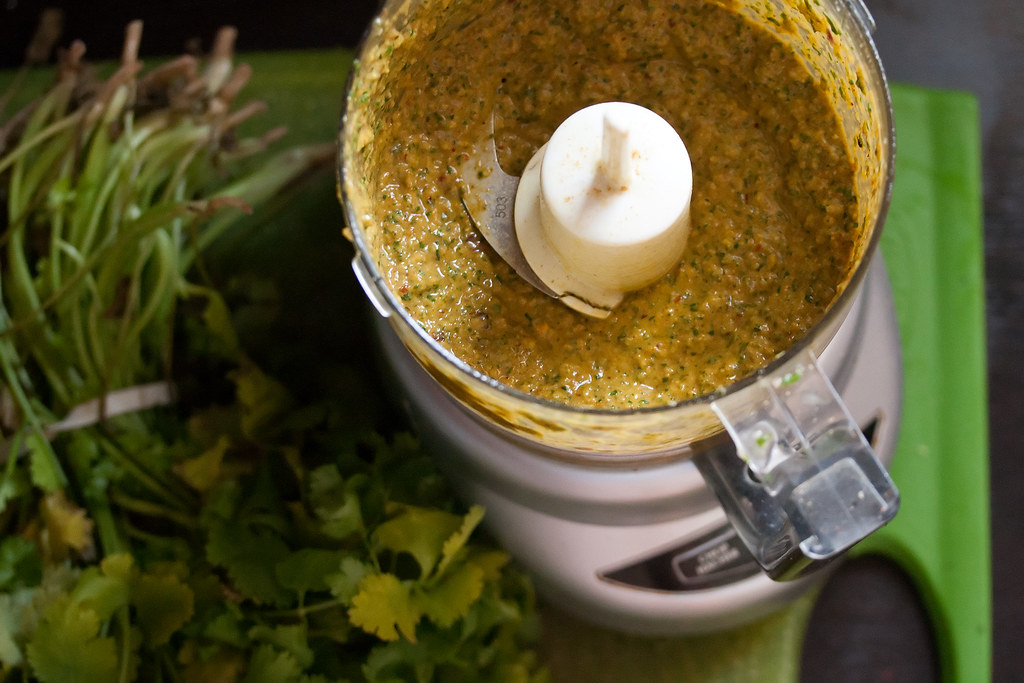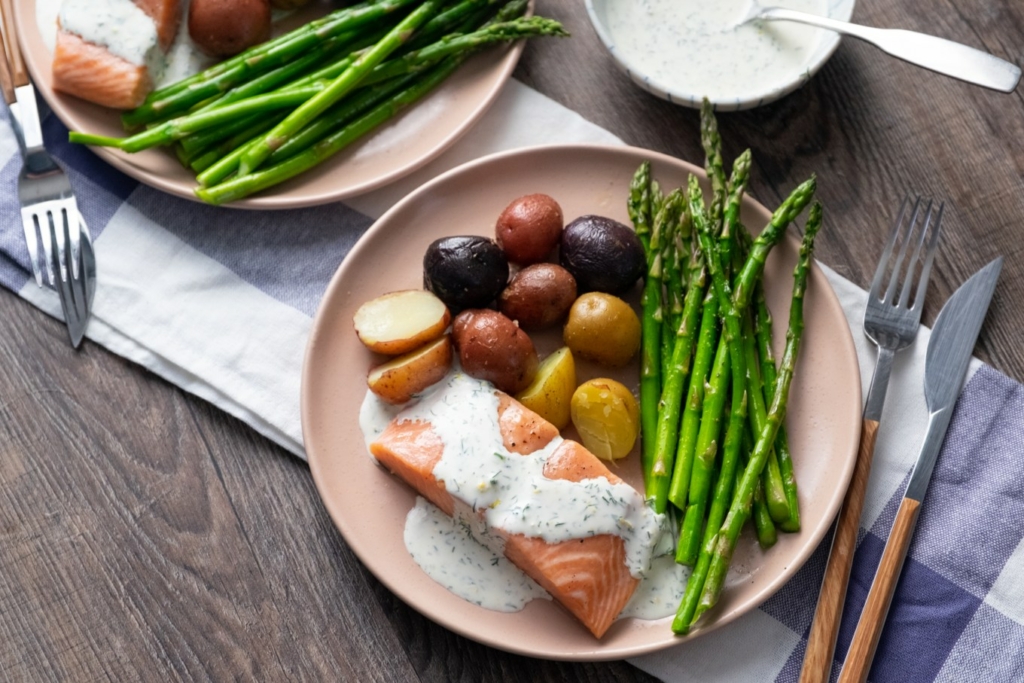A boneless, butterflied leg of lamb is the perfect candidate for sous vide because, just like steak, it can be easily undercooked or overcooked. This cut can be fatty; using the slow, sous vide method helps to break down the fat and connective tissue while maintaining flavor.
It’s an easy and perfect dish to serve for a group or at a cookout, as it’s best served at room temperature. You could sous vide the lamb in the morning, shock it in an ice bath, and store it in the fridge until an hour before serving. Allow the lamb to come to room temperature, then sear it on the grill or the stovetop, slice, and wait for the compliments!
Choosing Your Cut of Lamb
You can buy a half bone-in leg of lamb from the butcher and ask them to remove the bone and butterfly it for you. Or you can buy a boneless leg of lamb and have it butterflied (or do it yourself) . Some large grocery stores sell legs of lamb already butterflied.
To butterfly meat is to make cuts that allow you to open it out into one long piece of meat that is flat and of uniform thickness. Butterflied meat is perfect for finishing off on the grill as it cooks evenly and much faster than a whole leg.
Half a boneless leg of lamb can weigh around 3 to 5 pounds; you can allow around ⅓ pound per person (or just over 5 oz). If you prefer a more uniform, round slice of lamb, rub it with seasoning, roll back up, and tie with butcher’s twine. You could even stuff the lamb with herbs before rolling.
Seasonings and Marinades
This version of sous vide butterflied leg of lamb has a dry rub with lots of aromatic flavors. It is heavy on coriander, cumin, and fennel, which, as a combo, marry well with lamb. You can add fresh herbs to your sous vide bag, such as mint, rosemary, or dill.
Temperature guide for boneless leg of lamb
Just like steak, the degree of doneness of lamb is a personal taste. Here is a guide for sous vide, if you prefer the lamb either less or more well done than medium.
Temperature Degree of doneness Time
| 130°F | Medium-rare | 2 hours |
| 135°F | Medium | 2 hours |
| 145°F | Well done | 2 hours |
What to Serve With Butterflied Leg of Lamb?
Lamb is rich and fatty, and American lamb is gamier than imported New Zealand lamb, so it works well with fruit to cut through the richness. Apricots, figs, and pomegranates go particularly well with American lamb. The kick of fresh red chili pepper helps to lift the richness.
Lamb is a popular meat served across the Mediterranean, Middle East and India. Tzatziki, the Greek yogurt-based cucumber sauce, is a tasty accompaniment. Although creamy, the acidity of the lemon and the freshness of the cucumber help cut through the richness of the lamb. Lamb can carry bold flavors, and this dry rub version would go very well with salsa verde, chermoula, or chimichurri sauce.
As far as side dishes go, pilaf rice or a greek salad with orzo and halloumi would be a stellar accompaniment, or simply some toasted flatbread or pita. Sprinkling the lamb with toasted pine nuts or crushed pistachios before serving adds crunch and another layer of texture.
Temperature and cooking times for lamb
| Device | Temperature | Time |
| Suvie | 135°F | 2 hours |
| Immersion Circulator | 135°F | 2 hours |
Sous Vide Dry-Rub Butterflied Leg of Lamb Recipe
| Servings | Active Time | Preheat Time | Cook Time |
| 6 to 8 | 20 minutes | 30 minutes | 2 hours |
Ingredients and Tools
Equipment
- Suvie or immersion circulator
- Large pot or sturdy container (if using an immersion circulator)
- 2 to 4 vacuum sealer bags or freezer-safe resealable bags
- Chef’s knife and cutting board
- Tongs
- Pastry brush
- Cast-iron skillet, grill pan, or grill
Ingredients
- 1 ½ tbsp coriander seeds
- ½ tbsp fennel seeds
- ¾ tsp cumin seeds
- 1 tsp garlic powder
- 1 tsp granulated sugar
- ¼ tsp cayenne pepper (optional)
- 1 to 2 fresh mint sprigs (optional)
- 1 half boneless, butterflied leg of lamb (about 3 to 5 pounds)
- Olive oil for brushing
Directions

1) If you’re using a sous vide immersion circulator, pre-heat your water bath to 135°F.
2) In a small dry skillet over medium heat, toast 1½ tbsp coriander seeds, ½ tbsp fennel seeds, and ¾ tsp cumin seeds until toasted and aromatic, about 1 to 2 minutes. Transfer to a small bowl and allow to cool for 2 minutes.

3) Transfer the toasted seeds to a spice grinder (a mortar and pestle, or a resealable bag using a rolling pin or mallet) to coarsely crush. Return to small bowl. Add 2 tsp kosher salt, 1 tsp garlic powder, 1 tsp granulated sugar, 1 tsp ground black pepper, and 1/4 tsp cayenne pepper (if using), stirring to combine.

4) Transfer lamb to a cutting board, trim off the excess fat and sinew with a sharp knife, and discard.

5) Reserve 1 tbsp of dry rub. Sprinkle the rest over the meat on both sides, and thoroughly massage rub into the lamb. Transfer lamb to a vacuum or resealable bag.

6) Add 1 to 2 sprigs of fresh mint (if using) and seal the bag. If you are using resealable bags, use the water displacement method. Lower the bag into the heated water bath and cook for 2 hours. Cover the water bath with a layer of ping pong balls, foil, or cling wrap to keep the water from evaporating and sustain an even temperature.

If you are using your Suvie, place the bag into a Suvie pan and cover entirely with water (you may need to cut your lamb in half and divide between two Suvie pans). Insert pans into your Suvie and input the following settings.
Suvie Cook Settings
Bottom Zone: Sous Vide at 135°F for 2 hours
Top Zone: Sous Vide at 135°F for 2 hours
7) Once the lamb is cooked, remove bag with tongs. Carefully open the bag and discard any cooking liquid and the mint. Thoroughly pat the lamb dry with paper towels.

8) Brush lamb all over with olive oil, season with the remaining 1 tbsp dry rub, and cook over a hot grill (or cast-iron skillet on the stovetop) until charred in spots, for 1½ to 2 minutes per side.

9) Slice lamb and serve at room temperature with the accompaniments of your choice.

RECIPES TO TRY:
Lamb with Asparagus and Salsa Verde

Pilaf: The Culturally Diverse Rice Dish

Tzatziki

Charmed by Chermoula

Spectacular Spring Recipes

What’s the Best Way to Cook Lamb?

Braised Carrot and Beet Pitas

Pork Chops with Orzo Pilaf and Roasted Brussels Sprouts

Greek Orzo Salad with Halloumi

FAQs
Are the cooking temperatures safe?
Our recommended cooking temperatures for Sous vide and Suvie are lower than the USDA recommends; however, cooking times and temperatures are long enough and high enough for “pasteurization” to make your food safe. The USDA recommendations indicate the temperature needed to kill food pathogens instantly. By cooking for a longer time at a lower temperature, we are able to achieve the same effect. However, high-risk populations should use extra caution when preparing foods below the USDA recommended temperatures.
Can I use any type of plastic bag?
You can, however, make sure that they are made from polyethylene. Some branded plastic bags are made using polyethylene, a BPA and dioxin-free plastic that can safely handle sous vide cooking temperatures up to 190°F. Some generic branded plastic bags are made using cheaper polyvinyl chloride (PVC), which cannot handle high temps and contains chemicals that can leach into food.
Should I leave the lamb to rest before serving?
Nope! One of the great things about cooking with Suvie and sous vide is the evenness of temperature. While the outer edges will be hotter from the sear, the interior of the lamb will be cooked to the same temperature throughout. This means no resting time is necessary.
Can I cool the lamb chops after the sous vide process and sear them later?
For food safety and general food quality reasons, we don’t recommend it. Lamb should be seared and eaten soon after the sous vide step.
Do I have to pan sear my leg of lamb?
Nope! Pan-searing is a great way to enjoy lamb chops, but grilling or broiling are also great options.
Can I leave the lamb in the water bath indefinitely?
You can, but you shouldn’t. While leaving lamb in sous vide for extended periods won’t result in overcooking, it will have a negative effect on the overall texture of the meat.
What’s the best way to store my cooked lamb?
You can refrigerate leftover cooked lamb in an airtight container or resealable bag for 3 to 4 days in the refrigerator or 2 to 3 months in the freezer.



